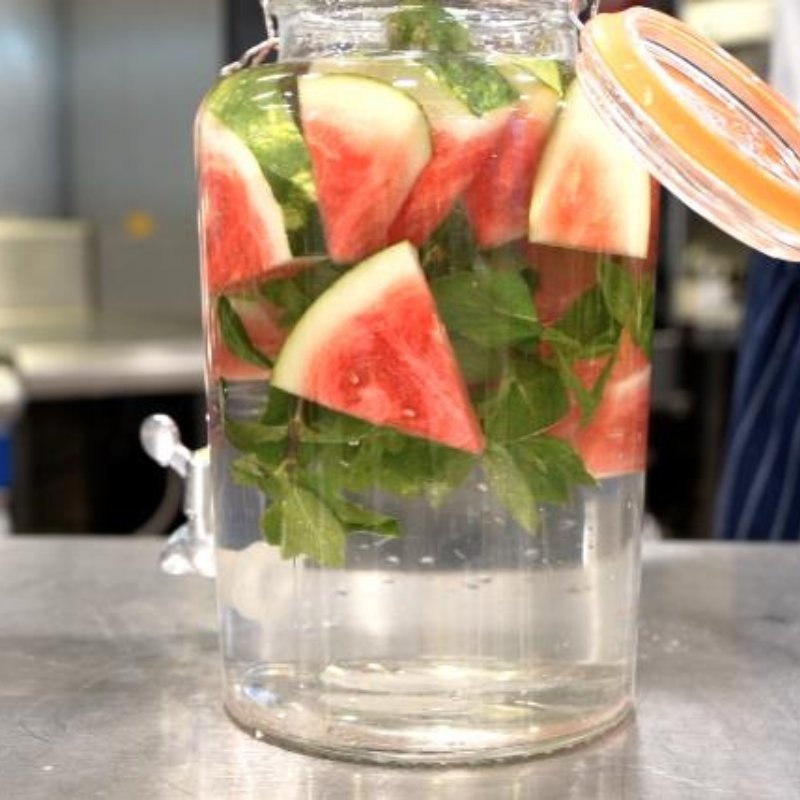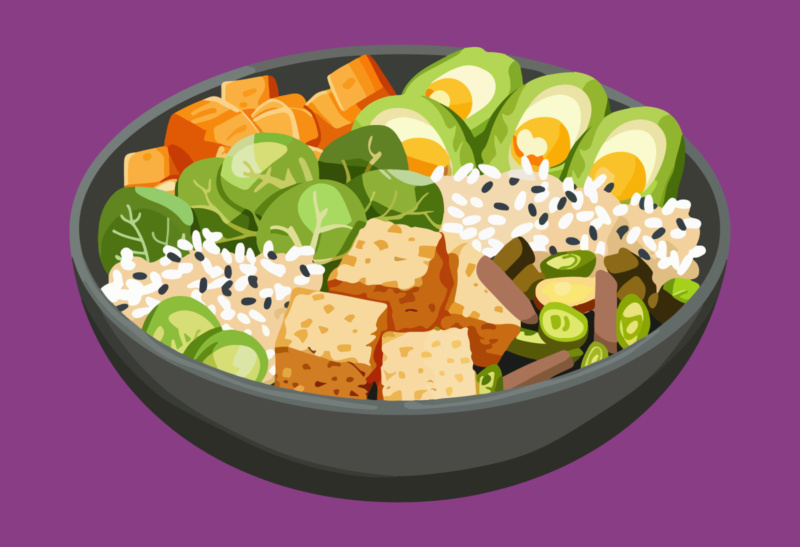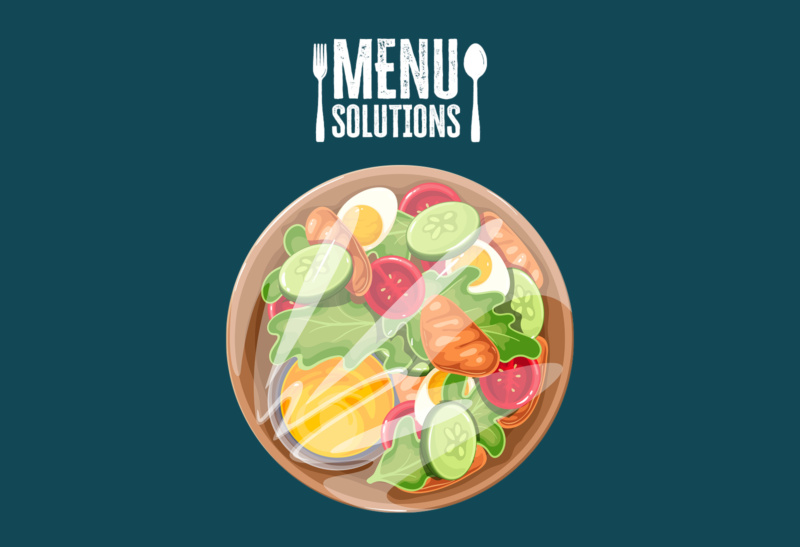Food is an integral part of our lives. It can be used to communicate, celebrate and build relationships, and is embedded in culture and religion. Food and nutrition also plays a key role in our health and wellbeing. Healthy eating – consuming a wide variety of foods in the right proportions – ensures our bodies get the nutrients they need to function properly and feel good.
From Monday June 10th to Friday June 14th 2024, the British Nutrition Foundation will promote the importance of healthy eating with their annual event, Healthy Eating Week1.
In this blog, our Nutrition Manager, Heather Dolan, will look at the five themes for Healthy Eating Week, discuss why they are important and how everyone can get involved.
1. 5 a day
The first theme of the week is eating 5 portions (400g) of fruit and vegetables every day.
You might be thinking, “I already know this”, but hear me out. There is a wealth of evidence demonstrating the positive effects of eating plenty of fruit and vegetables on our health. However, year after year, national data reveals that only 1 in 3 adults get their 5 a day2.
If you feel confused by nutrition and health, I’m here to reassure you that the principles in this blog are a great place to start. Supplements and trendy products may tempt you with their seemingly impressive claims, but there’s no denying it, fruit and vegetables are a fundamental part of a healthy, balanced diet.
Why are we encouraged to eat at least 5 different portions of fruits and vegetables every day?
- Fruits and vegetables contain an array of nutrients which are essential for good health, including vitamins, minerals, phytochemicals (beneficial compounds found in plants) and fibre3
- They can help reduce the risk of non-communicable diseases such as heart disease, stroke and some cancers4
- They are low in fat and calories, so when eaten as part of a healthy balanced diet, they can help maintain a healthy body weight5.
It’s also important to mention that it’s not just about the nutrients that a food contains. The physical structure, or “food matrix”, affects how our bodies are able to access and utilise energy and nutrients.
Generally speaking, “whole foods” such as fruits and vegetables have a more complex matrix compared to more highly processed foods. This means our bodies have to work harder to digest them, resulting in nutrients being released more slowly and/or to a lesser degree.
There are a number of positive implications of this, such as helping to control blood sugar levels.
So, what counts as a portion of your 5 a day?
| Food or drink | Portion | Notes |
| Fresh, frozen or canned fruit and vegetables | 80g | Canned should be in water or natural juice, no added sugar or salt. Potatoes, yams, cassava and plantain do not count (because they are normally eaten as starchy carbohydrates). Sweet potatoes, parsnips, swedes and turnips do count (because they are usually eaten in addition to starchy carbohydrates). |
| Dried fruit | 30g | No added sugar |
| Beans and pulses | 80g | Can only count as 1 of your 5 a day, no matter how much you eat (this is because beans and pulses contain fibre, but less vitamins and minerals than fruits and vegetables) |
| Fruit and vegetable juices and smoothies | 150ml | Should be unsweetened, 100% fruit and vegetables Can only count as 1 of your 5 a day, no matter how much you drink (this is because juicing removes the fibre from fruit) |
There are endless ways to achieve 5 a day, here are some suggestions:
Breakfast: 1-2 portions
- Wholegrain cereal with chopped banana and dates
- Porridge with sliced apple, raisins and cinnamon
- Yoghurt, granola and frozen berries
- Snacks: 1-2 portions
- Could be sweet – an apple with peanut butter to dip
- Or savoury – carrot and cucumber sticks with houmous or salsa
- Lunch: 1 portion
- Add some spinach, grated carrot or diced pepper to a sandwich or wrap
- If you prefer a hot meal – add in frozen peas, tinned sweetcorn, beans or pulses
- Dinner: 2 portions
- Remember – onions, garlic, chopped tomatoes and tomato puree count!
- Swap some meat for beans or pulses in stews, curries and casseroles
- Add a side of broccoli, roasted with lemon and garlic
- Total portions: 5-7


2. Hydration
Nutrition and hydration are often considered together as they are both essential components of good health and wellbeing. Drinking enough fluids supports normal bodily functions and prevents dehydration, which can lead to issues including headaches, tiredness and lack of concentration6.
Water has many vital roles in the body, from transporting nutrients in the blood, to regulating body temperature, to removing waste products through urine7.
So, how much should you drink?
Adults need around 1.5–2 litres of fluid every day. This equates to 8-10 drinks in a typical 200ml glass or mug. However, you may need more if you are in a hot climate, do a lot of exercise, or are recovering from an illness. Children need around 6-8 drinks per day8.
Water is the cheapest and best option for hydration. But milk, tea, coffee, squash and other sugar-free drinks count. We can also get fluid from the food we eat such as soups, stews, curries and fruits and vegetables with a higher water content including strawberries, cantaloupe melon, celery and spinach.
If you don’t like the taste of water – try sparkling with a wedge of lemon or lime.
Alternatively, our infused water recipes use fruit peel, leftover herbs and spices – so are a hydration and food waste win!


3. Movement
We also know that movement, in its many forms, is a central part of health and wellbeing. Movement also links nicely with nutrition and hydration, as what we eat and drink (and in what quantities) has an effect on our exercise performance.
There is an overwhelming amount of evidence demonstrating the health benefits of regular exercise, including a lower risk of developing heart disease, stroke and some cancers. Exercise also reveals benefits in the shorter term, such as improved sleep, mood and reduced risk of stress9.
The last Health Survey for England revealed that 70% of men and 59% of women aged 16 and over met the guidelines below. As our lives become increasingly busy it can feel as if there “just isn’t enough time”. But you might be surprised to learn what counts as movement and how easy it can be to hit the recommendations10.
So, how much movement should you do?
Adults should aim for 150 minutes of moderate intensity activity per week (brisk walking, a slower bike ride, yoga, mowing the lawn, hiking, dancing) which should increase your heart rate, breathing and make you feel warmer.
Alternatively, 75 minutes of vigorous activity per week offers the same health benefits (running, a faster bike ride, lifting weights, swimming, playing football) which should make your breathing hard and fast. When taking part in vigorous exercise, you won’t be able to say much without stopping for breath.
Most exercises can be perceived as either moderate or vigorous, depending on your level of fitness and the effort you put in. Use the guidance above to determine the intensity of an activity for you and keep in mind that this perception will likely shift as your fitness improves.
Finally, try and spread activity evenly across the day and week and, where you can, reduce time spent sitting or lying down for long periods of time11.
4. Fibre
Gut health has been getting a lot of attention recently, so let’s talk about fibre and how you can support your digestion.
Fibre is a type of carbohydrate found in plants that our bodies can’t digest. Most carbohydrates (such as sugars or starches) are broken down in the small intestine, however, fibre keeps going and reaches the large intestine intact.
Fibre has lots of important functions – it helps our gut work normally and there is strong evidence that eating plenty of fibre can help reduce the risk of some health conditions, like cardiovascular disease, type 2 diabetes and bowel cancer12.
Some types of fibre are fermented by the “good bacteria” that live in our gut, and research indicates that a diet rich in a variety of fibre may help increase these bacteria.
It’s important to mention that the science in this area is still emerging, however, there is a growing body of evidence that highlights the importance of these friendly microorganisms on various aspects of our health and wellbeing, including our immune system and brain function13.
So, how much fibre should you aim for?
- Adults should consume 30g of fibre every day
- The amount a child should consume depends on their age14
| Age (years) | Recommended fibre intake |
| 2-5 | 15g per day |
| 5-11 | 20g per day |
| 11-16 | 25g per day |
| 17 and above | 30g per day |
This should come from a variety of sources including fruit, dried fruits, vegetables (especially peas), beans and pulses, nuts, seeds, wholegrains (such as oats, brown or wild rice, whole oats, wholegrain pasta, whole meal bread, wraps and crackers and wholegrain breakfast cereals).
When shopping, compare products such as breakfast cereals, bread and pasta and look out for those that are:
- High in fibre: at least 6g of fibre per 100g
- Source of fibre: at least 3g of fibre per 100g
Our Everyday Favourites wholemeal tortillas (18457) contain three times the amount of fibre as our wheat tortillas (07061) (7.2g and 2.3g of fibre per 100g, respectively). Our Everyday Favourites whole wheat fusilli (29580) contains double the amount of fibre as our regular fusilli (70486) (6.5g and 3g of fibre per 100g, respectively).
5. Food waste
Our final theme is reducing food waste, which can also align with healthy eating.
Food waste happens at all stages of the supply chain including on farms, during transportation, processing and finally during meal preparation and distribution.
Two obvious ways to reduce food waste are to purchase less or consume more. Depending on the food, consuming more might go against healthier eating principles. However, with increased awareness and careful planning, we can waste less food whilst positively impacting nutrition15.
So, what can you do to reduce food waste?
- Plan menus and meals carefully, making sure you are realistic
- Utilise frozen fruits and vegetables such as peas and raspberries
- When you are left with a surplus ingredients, design a recipe to utilise these items or where appropriate, freeze them for future use
- When you are left with a surplus of a dish, offer a promotion to increase uptakes or where appropriate, freeze portions for future use
- Practice “root to stem” cooking, utilising every part of an ingredient. For example, make infused waters from fruit and vegetable peels or add stems, leaves and stalks into soups and sauces
- Recycle intact items (before they spoil), for example, apples, oranges and bananas and incorporate into a recipe the following day
From eating a variety of fruits and vegetables, to opting for higher fibre starchy carbohydrates, we hope this blog has inspired you to incorporate these healthy eating principles into menus for your customers, or meals for yourself!
Understanding your customer’s dietary requirements, personal preferences and expectations around healthier dishes is vital. A survey is a great place to start and don’t be afraid to trial new concepts and flavours and ask for their feedback.
Whether this year or next, why not consider getting involved in Healthy Eating Week. The British Nutrition Foundation has an array of guides, posters and other resources on their website for primary schools, secondary schools, workplaces and more.
Furthermore, check us out on Instagram, LinkedIn, and YouTube for more blog posts and videos like this.
References:
- https://www.nutrition.org.uk/healthy-eating-week/
- https://www.ethnicity-facts-figures.service.gov.uk/health/diet-and-exercise/healthy-eating-of-5-a-day-among-adults/latest/
- https://www.bda.uk.com/resource/fruit-and-vegetables-how-to-get-five-a-day.html
- https://www.who.int/tools/elena/interventions/fruit-vegetables-ncds
- https://www.nhs.uk/live-well/eat-well/5-a-day/why-5-a-day/
- https://www.bda.uk.com/resource/fluid-water-drinks.html
- https://www.nhs.uk/live-well/eat-well/food-guidelines-and-food-labels/water-drinks-nutrition/
- https://www.bda.uk.com/resource/the-importance-of-hydration.html
- https://www.nhs.uk/live-well/exercise/exercise-health-benefits/
- https://digital.nhs.uk/data-and-information/publications/statistical/health-survey-for-england/2021-part-2/physical-activity
- https://www.nhs.uk/live-well/exercise/physical-activity-guidelines-for-adults-aged-19-to-64/#:~:text=do%20at%20least%20150%20minutes,not%20moving%20with%20some%20activity
- https://www.bda.uk.com/resource/fibre.html
- https://www.nutrition.org.uk/nutritional-information/fibre/
- https://www.nhs.uk/live-well/eat-well/digestive-health/how-to-get-more-fibre-into-your-diet/



